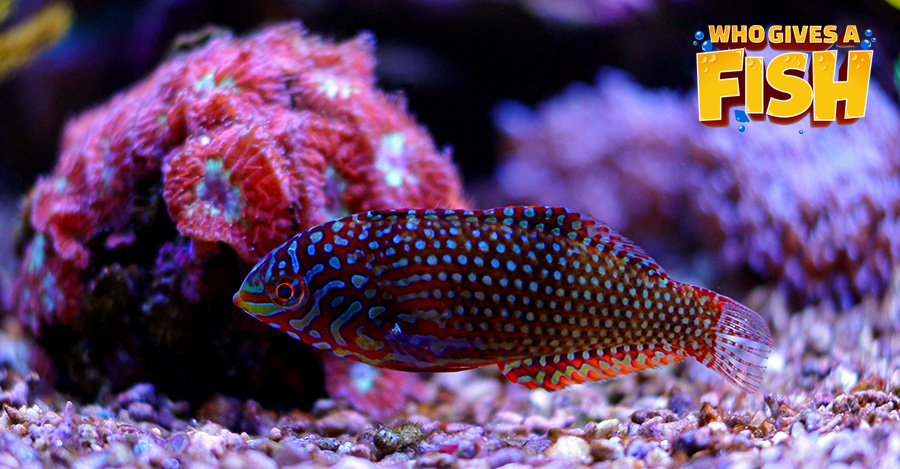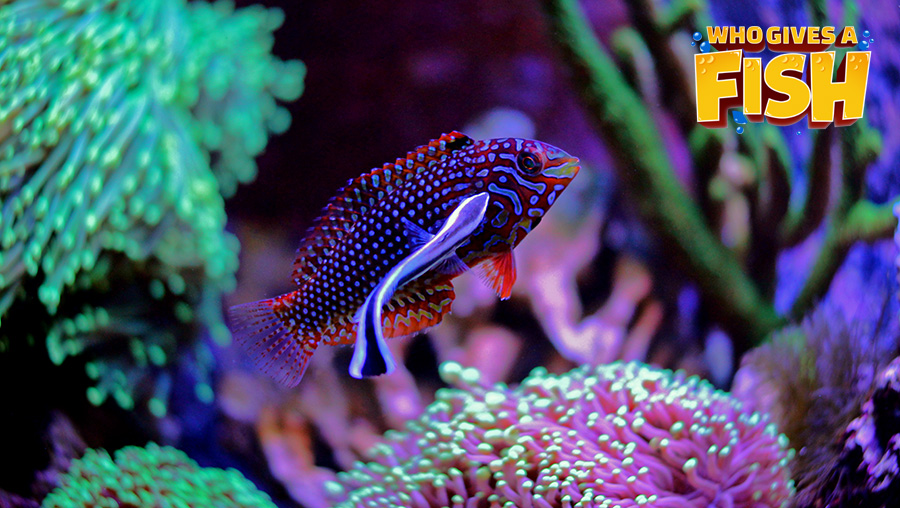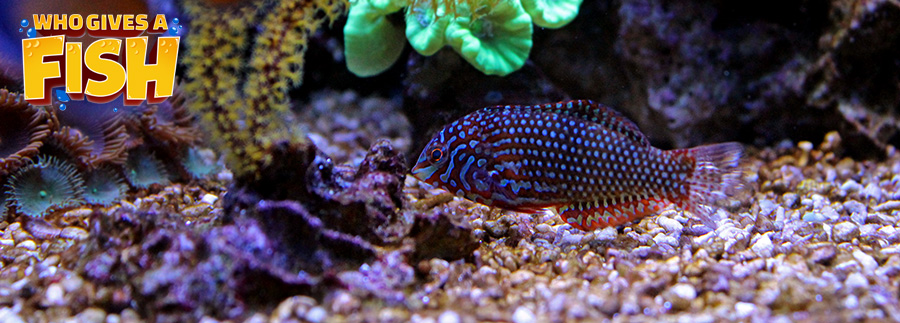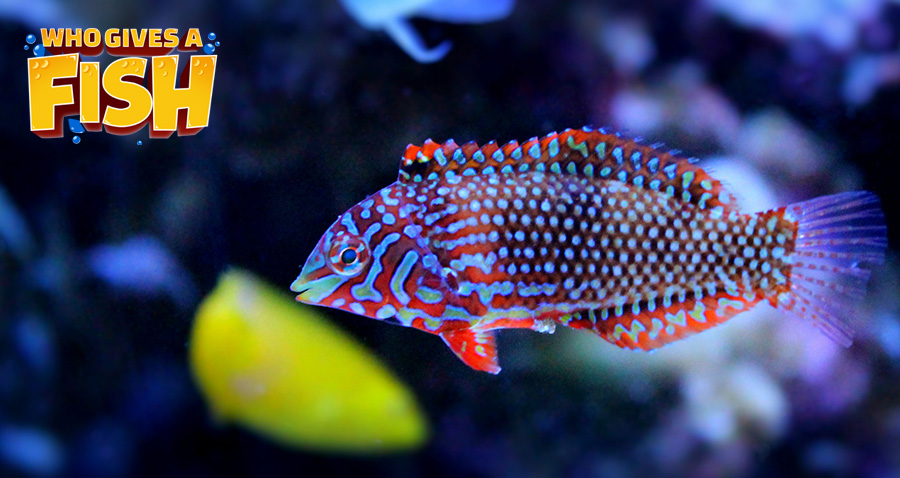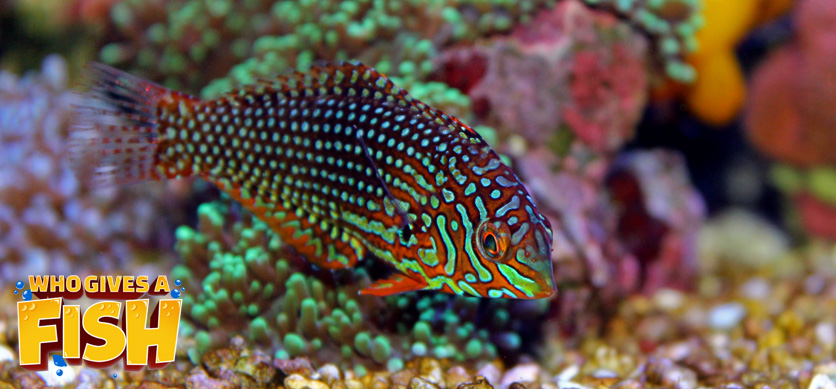Leopard Wrasse
As seen in all the Leopard Wrasses, this one has a very distinctive spotted Leopard like decoration. It is however, not only known as the Blackspotted Wrasse, but also as the Guinea Fowl Wrasse. All Wrasses in the Macropharyngodon genera are born as females, which includes the Blackspotted Wrasse.
In a pair or group of wrasses, if there is no male currently present, one will switch to become male and its color changing with it. An adult male will have an orange-red colored body with green spots on it and a dark “ear” spot and lines on its head.
- Experience Level: Advanced
- Hardiness: Moderate
- Minimum Tank Size: 50 gal (190 L)
- Size of fish: 6 inches (15.2 cm)
- Temperament: Semi-Aggressive
- Temperature: 74.0 to 79.0° F (23.3 to 26.1° C)
- pH Range: 8.1-8.4
- Diet: Carnivore
Table of Contents
Introduction
Aquarium Setup
Difficulty
Feeding
Breeding and Social
If the Blackspotted or Guinea Fowl Wrasse is successfully introduced to an aquarium, it will become a great, peaceful fish that can be housed with many other species including its own. It is known to be one of the few Wrasses that can be kept with its own species. This is provided that the make up is correct, with one male to one or several females.
They are considered passive fish, and reef safe- however they are not recommended for beginner hobbyists. They are known for often being quite hard to get established within a tank, with the proper environment being setup for them from the start and maintained. Many hobbyists purchase these fish, only to find them deceased shortly after.
The Leopard Wrasse has been seen to exhibit many unusual behaviors. As they come from the Indo-Pacific region, they will often have different sleeping habits to other fish in your tank. Potential predators can be seen shown a strange dance by this Wrasse to scare it off. Observers of this unusual dance have put its successfulness down to the fact that many predators are so confused, and are assured the fish has problems, so moves on. A backup escape plan for the wrasse is to quickly bury itself in the sand.
This is in fact their favorite sleeping position and can often be very habitual with their bed time hours. Like many fish who use the substrate as protection, the morning will bring a small head of the Wrasse popping out to ensure the coast is clear. They have been seen to be a tad lop sided once first emerging in the morning, before becoming normal again and foraging through the tank.
Juveniles and females will have a light green-white color with several irregular black/brown spots. Adult males will appear more streamlined with an orange-red body and dark green spots, a dark “ear” spot and lines on its head. Leopard Wrasses have a life expectancy of between 5-8 years in captivity.
The Leopard Wrasse being kept clean by a Cleaner Wrasse in an aquarium
Aquarium Setup
A healthy and easy transition from wild life to captive life will depend mainly on the availability of the right nutrition for the Leopard Wrasse. A minimum of a 3-inch sand bed is essential, with even more being OK. Plenty of live rock with crustaceans and a refugium producing pod populations is ideal with the tank being topped by a lid to stop any stress jumping.
An established marine tank, ideally over 3 months, is required before adding a Leopard Wrasse. Mature live rock that have micro-crustaceans living in it is vital for nutrition. A sand bed of at least 3 inches should be provided for their sleeping and hiding behaviors.
As with all new additions, they should be quarantined from 4-6 weeks if possible to ensure they are free of parasites before adding to your tank. Approximately 75%-85% of these Wrasses are known to have intestinal worms, so should be treated for worms asap.
Once its time to introduce the wrasse to your main tank, use a couple of nets and catch them at night. Using nets is far more ideal than a container, as these Wrasses may panic and swim frantically into the sides, damaging themselves. They will be sleeping under the sand and are known for picking the same spot each night, so it should be easy to find them.
Once you have the Wrasse caught, move it to your main tank. If there is any difference in temperature to the quarantine tank, you will need to acclimatize it for a while first. If so, transfer the wrasse to a plastic bag and float it in the tank for 10-15 minutes before letting it free.
A newly introduced Wrasse will most likely make for the sand bed and stay there for some days before emerging. Don’t panic if they are not seen for a while, they will eventually pop their heads out of their new beds! Try adding a lid to your tank as well, as they have been known to jump in the presence of more aggressive tank mates.
Leopard Wrasse Aquarium Guide
- Minimum Tank Size: 50 gal (190 L)
- Suitable for Nano Tank: No
- Live Rock Requirement: Yes
- Substrate Type: Prefers sandy bottom.
- Lighting Needs: Any
- Temperature: 74.0 to 79.0° F (23.3 to 26.1° C)
- Breeding Temperature: 79.0° F (26.1° C)
- Specific gravity: 1.020-1.025 SG
- pH Range: 8.1-8.4
- Brackish: No
- Water Movement: Any
- Water Region: All areas of the tank.
Difficulty
As mentioned above, the Leopard Wrasse should only be housed by experienced hobbyists as they have a strong history of being difficult to keep. A well-established aquarium that has steady water parameters and a healthy population of micro-crustaceans is ideal. They should not be housed with other fish who require the same types of food as them as they may be easily pushed away from it. Like many other fish, they will not tolerate copper in the tank.
Feeding
The Leopard Wrasse/ Guinea Fowl Wrasse/ Blackspotted Wrasse are carnivores, so this needs to be replicated in your tank. In the wild they will feed on things like small inverts e.g. foraminiferan (small shelled protozoa) and may also eat snails. They have large canine teeth which allow them to smash the shells of these types of foods. Copepods and Amphipods are also favorites of theirs.
These Wrasses will benefit greatly from the provision of live foods like black worms and feeder shrimp. After this, you should begin to introduce them to such foods as plankton, krill, mysis and mussel meat- feeding several times a day. If you can, inject (gut load) these live foods with vitamins made for marine fish. If feeding prepared foods, try soaking them in the vitamins before feeding. Refugium’s will also help by producing healthy pod populations.
Leopard Wrasse Feeding Guide
- Diet: Carnivore
- Flake Food: Sometimes
- Pellet / Tablet: Sometimes – Soak pellets in water before introducing to the tank.
- Live foods (fish, shrimp, worms): Feeder shrimp, black worms.
- Frozen Foods: Mysis, krill and clean, raw fish/shellfish.
- Meaty Food: 100% of their diet.
- Feeding Frequency: Several times per day.
Breeding
All these Wrasses will be born as females and individuals will change into males as the situation requires.
Like most marine fish, they have not yet been successfully bred in captivity. In the wild, males and females can be observed depositing eggs and sperm up in the water column by shooting up 2 – 3 feet at a time. These fertilized eggs are then caught by the current and taken out to a safe area of the ocean.
We are unaware of any captive breeding.
A stunning red and green Leopard Wrasse
Social
The Leopard Wrasse/ Guinea Fowl Wrasse/ Blackspotted Wrasse is best when housed as a pair or in a group. If they are to be housed as more than 1, a larger tank is required. Thankfully, it is one of the only Wrasse genus that can be housed with more of its own kind with 1 becoming a male and the rest females.
They are rated as being reef safe but will feed on micro-crustaceans in and around the corals. They will live well with other passive natured fish and semi-aggressive fish like Rabbitfish, Jawfish, Dwarf Angels and Dottybacks. If the plan is to house them with some other semi-aggressive fish, ensure you add the Wrasse first to allow it to develop a home base.
Never house them with fish like Groupers, Scorpionfish or Puffers that are big enough to be able to eat them. Slower feeding species like Pipefish and Seahorses will not do well in the presence of these active feeding Wrasses.


